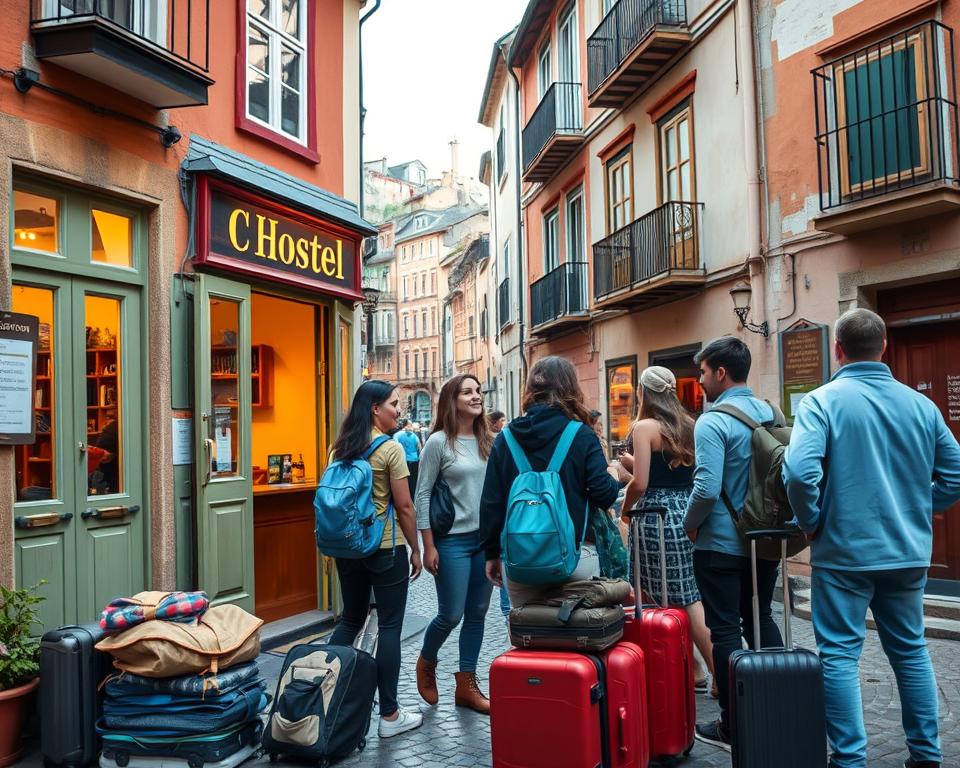Advertisements
Have you ever wondered if you can really visit interesting destinations without spending too much? With a practical approach and free tools in Internet, you can organize travel from the United States and make informed decisions.
Before purchasing flights, check passports with at least six months' validity, visa requirements, and vaccinations. Compare prices on Skyscanner or Google Flights and review accommodations on Booking.com and TripAdvisor to avoid surprises.
Choosing a destination based on your budget and preferences improves the experience, especially if the cost of living is lower. Use Google Maps to plan locations and routes, and take offline notes in case you lose connection.
Practical tips: Control your daily budget, avoid exchanging money at airports, and consider cards with low fees. Traveling light and being flexible with dates reduces expenses and gives you more time to enjoy.
Introduction: Why now is the best time to plan a cheap trip
If you have time and manage your dates well, you can find real deals on flights and accommodations today. The current economic context has increased competition between airlines and accommodations, which could be an advantage for those looking for lower prices.
Buying in advance helps you catch occasional fare drops. During the off-season, prices tend to drop outside of peak holiday and event periods. Consider nearby airports and flexible schedules to expand your options.
- With time and flexibility in dates, it's easier to find good rates on flights and accommodations.
- Check the local calendar: festivals and holidays raise the costs of the venue.
- Today there is more information and digital competition to compare offers and adjust your plan.
- There's no single way to save; combine tactics based on your profile and destination.
Remember that promotions appear from time to time. Before paying, check the terms, exchange policies, and local regulations to avoid surprises.
Realistic Budget: How to Define How Much to Spend Without Losing Experience
Setting a realistic spending limit helps you enjoy your time without financial surprises. Start by defining a budget total by country or destination and assigns percentages to flights, accommodation, food, activities and transportation.
Control tools and templates
Use Google Sheets templates or web-based budgeting apps. Calculators like NerdWallet help you project expenses and create an emergency account.
Practical example and margin for unforeseen events
Example: a backpacker in Southeast Asia will have a cheaper day than a European capital. I'm not promising guaranteed savings; these figures are indicative.
- Set aside a fund for unforeseen medical expenses or route changes.
- Set aside daily money from the emergency account.
- Includes hidden costs: insurance, transportation, tips, and mobile data.
Seasonality and payment method
Check up-to-date information on festivals and holidays: peak season makes everything more expensive. Avoid exchanging cash at airports; instead, use cards with low fees and surcharge-free ATMs.
Cheap flights with strategy: from search engine to smart shopping
Taking advantage of search engines and flexibility helps you find better fares on flights. Start by comparing months and destinations on Skyscanner and Google Flights to spot price windows. Skyscanner allows you to search by full month or “anywhere”; Google Flights makes it easy to explore flexible dates.
How to create alerts and monitor changes
Activate price alerts and monitor trends before purchasing. If you notice frequent increases and decreases, wait for a reasonable pattern within your budget.
Alternative routes and connection security
Check the box nearby airports to see cheaper options. When combining flights on your own, leave plenty of room between flights to avoid jeopardizing your connection.
- Compare months and destinations to detect windows.
- Activate alerts and analyze trends before paying.
- Use incognito and delete cookies if you notice sudden changes.
- Consider alternative airports if the transfer is easy and affordable.
- Review baggage policies and travel light to avoid fees.
Always read conditions and save screenshots with the fare and route. Consider arrival time and nighttime transportation options before finalizing your purchase.
Documentation, requirements, and traveler health: check before purchasing
Before purchasing tickets, confirm that your documents and vaccinations meet the regulations of the destination country. This helps you organize your trip more safely and without rushing.
Passport, visas and electronic authorizations
Check that your passport does not expire within six months of entry. Check whether your destination requires a visa, e-Visa, or ESTA, depending on your nationality.
Countries like China and India often require visas for many nationalities; some electronic authorizations take days or weeks.
Vaccines and health requirements
Consult official health sources for recommended vaccinations and current restrictions. Most places have relaxed COVID-19 requirements, but it's a good idea to check before traveling.
Travel Insurance: What to Compare
Compare coverages Medical, lost luggage, cancellation, and 24/7 assistance. Read the limits and exclusions; don't assume everything will be covered.
“Keep digital and physical copies of your documents and carry your consulate numbers.”
- Review country requirements in advance and confirm processing times.
- Be aware of traffic procedures and stay limits.
- Before purchasing flights, do a final check to see if the information changes.
Choose your destination and season wisely: where your money goes the furthest
Prioritize places with low cost per day and good connections It allows you to get more out of your budget. Choose a destination based on your needs: climate, safety, and easy connections from your airport.
Regions with the best price ratio
Asia, Eastern Europe, North Africa and many Latin American countries offer good value for money.
- Asia: Thailand, Vietnam, Indonesia and Nepal tend to yield a lot per number of days.
- Eastern Europe: Bulgaria, Poland, and Romania combine low prices and easy travel.
- North Africa and Latin America: Morocco, Mexico, Colombia, and Peru are popular options for budget travel.
Season: low, medium and high
Low season lowers prices and traffic. High season raises flight and accommodation prices. The shoulder season is usually the best balance between weather and prices.
- Analyze local events that increase costs and move them to another account.
- Use the internet to compare accommodations, flights, and recent reviews.
- Calculate the number of days based on your pace and budget, and consider alternative airports.
Savings-saving accommodations: hostels, apartments, hotels, and more
Choosing the right accommodation can cut costs and improve your experience at your destination. Before booking, consider your priority: socializing, cooking, or relaxing.

When to choose each option
Hostel: Cheap and social; ideal if you're looking to meet people. Contrast: less privacy.
Private room: A balance between price and relaxation. Perfect for short trips.
Apartment: Cooking reduces eating out and lowers costs. It requires cleaning and management.
Hotel: services and security; the price increases, but it saves time on paperwork.
Connected areas and helpful reviews
Choose neighborhoods with metro or bus connections: often, a well-connected suburb costs less and offers better quality.
Use filters in Booking by price and rating, and sort by “rating and price”.
Check before booking
Read reviews on TripAdvisor and on the platform itself. Check the number of reviews and recent dates.
- Choose according to your style: social, private, cooking or services.
- Evaluate transportation to save on transfers.
- Save screenshots and compare at least three options.
- Mark locations on your map to plan activities.
Transportation to your destination: get around for less and save time
Choosing how you get around makes a difference in budget and experience. Plan based on length of stay and destination type to optimize routes and costs.
Public transport, passes and local apps
Research local apps and buy fertilizers If you'll be there for several days, rechargeable cards or integrated metro-bus passes often make frequent trips cheaper.
Download the system's official app and check nighttime schedules and holiday frequency.
Walking and cycling: safe routes and close-up experiences
Walk and using a bicycle is economical and brings you closer to the local atmosphere.
Check maps of bike paths and urban rentals; prioritize safety and wear a helmet if required.
Rideshare and taxis: when to use, when not to use
Use rideshare as a supplement when public transportation doesn't cover schedules or zones. Compare fares and avoid unauthorized taxis.
Buses within the United States: Tickets, ID, and Tips
Purchase tickets online or at the station and bring a valid ID (license or passport). Arrive early at the terminal for smooth boarding.
Include the cost of transportation in your budget and consider luggage storage if you need to move quickly between check-in and check-out.
- Evaluate a rechargeable card or day pass.
- Plan routes with examples of real-life transfers and estimated times.
- Check nighttime schedules and weekend frequency.
Money abroad: cards, ATMs and cash
Managing your money in another country can prevent surprises and reduce unexpected costs. Before you leave, check your account fees and notify your bank about your travel dates.
Fee-free cards and payments in local currency
Prioritize paying in local currency. Decline the payment option in your currency (DCC): it often offers lower prices.
Look for a card with low transaction fees and activate security alerts.
Withdraw from ATMs with fewer fees
In every country, there are ATMs with and without fees. Find the least expensive ones before withdrawing.
Withdraw a reasonable amount to reduce transaction fees, and avoid exchanging large sums at airports.
Cash backup and security
Carry backup cash and divide your money into different places. Keep a second card in a separate location.
- Set up bank alerts and confirm travel notices.
- Save blocking numbers and test daily limits.
- Keep receipts and review transactions for duplicate charges.
“Paying in local currency and choosing ATMs with lower fees can make all the difference in your destination budget.”
Itinerary and activity ideas that don't break the budget
Design a practical itinerary that mixes free and low-cost activities to take advantage of time and reduce spending on transport. Create a list prioritized locations and group them on Google My Maps: mark airports, accommodations, and key attractions to estimate travel times.
My Maps It allows you to optimize routes and see how long it takes you to reach points. This way, you can decide if a tourist pass is worth it based on your schedule and the number of attractions you want to visit.
- Alternate free attractions and paid tickets to save.
- Join free walking tours: they are usually tip-based and provide good guidance.
- Look for museums with free days or discounts based on time slots.
To eat well without spending a fortune, opt for markets, daily menus, and cooking when your accommodations allow. Consider stalls with high turnover and visible hygiene; they're usually the safest option.
“Group nearby spots and book in advance at places with capacity to avoid long lines.”
Example: Add the airport, hotel, and three nearby attractions to My Maps to calculate the time between them and decide whether to buy a pass or pay for individual tickets.
Smart packing: pack just enough to save money and move better
Packing wisely saves you time and avoids unnecessary charges at the airport. Consider your destination's climate and the activities you'll be doing to decide what pieces to bring.
Practical list according to climate and activities: Create versatile outfits and assign pieces by day. Prioritize layers, comfortable shoes, and items that serve multiple functions.
Before leaving, check the things Essentials: medication, documents, and chargers. Weigh your suitcase at home and remove items you're carrying "just in case."
Hand luggage tips for low-cost airlines
Follow airline limits and restrictions to avoid checked baggage fees. Store liquids in approved containers and organize pockets for security checks.
- Carry an empty reusable bottle and a small padlock.
- Pack a light change of clothes in your carry-on depending on your arrival time.
- Adjust your list after each outing to improve the system.
“Traveling light not only saves money on flights, but it also allows you to move more freely and quickly.”
Connectivity and final preparations that make the difference
Having information and transportation arranged from the moment you arrive completely changes the start of your trip. Arriving with active internet reduces uncertainty and allows you to arrange transfers, reservations, and check-ins in minutes.
eSIM and local SIM: internet from the moment you land
eSIM It gives you data when you land without having to search for a store. Buy it beforehand and activate it according to instructions. A local SIM card is usually cheaper if you're traveling for several days.
Evaluate coverage and price based on your destination and usage. I don't guarantee perfect signal in all areas.
Airport-city transfer and advance reservations
Book a transfer if you're arriving at night or on holidays. Compare bus, train, and rideshare options based on time and cost.
Copies of documents, online check-in and plan B
- Check in online within the allowed dates to save time and avoid fees.
- Keep digital and physical copies of your passport, policy, and reservations in one accessible list.
- Prepare an account with emergency contacts, a card enabled for international purchases, and an external battery.
“Confirm addresses and schedules the night before: small adjustments prevent major delays.”
Budget-friendly travel step by step: integrate everything into one actionable plan
With a clear checklist, you can combine your budget, flights, and documentation into a quick and practical plan. This way you reduce errors and make better use of your time before leaving.
- Choose your destination based on season, price, and duration to maximize your days.
- Check your passport, visa, and health requirements well in advance.
- Compare flights with flexible dates and set a realistic spending limit.
- Book accommodations based on area, price, and reviews; prioritize nearby transportation.
- Plan activities in My Maps and create a realistic calendar by area.
- Define your money management system: cards, cash, and limits; have backup accounts.
- Organize local transportation and calculate times between key points.
- Pack light depending on the weather and activities; carry only the essentials in your carry-on bag.
- Set up internet (eSIM/SIM), check in, and save digital copies.
- Review everything 48 hours in advance and adjust what's necessary in a simple way.
Example: Mark the airport, accommodations, and three attractions on your map and calculate routes. I don't promise resultsAlways check official sources and conditions before booking.
“Check requirements and confirm schedules the night before: small adjustments prevent major problems.”
Conclusion
Have a clear list and consult good websites It helps you organize your trip more safely and with fewer surprises. Planning ahead, comparing accommodations, and checking seasons reduces prices without sacrificing the experience.
Combine tips Practical tips: Alternate free and paid attractions, prioritize efficient transportation, and choose a well-connected location. Compare information with official sources and update your list several times before your trip.
Search for destinations and countries based on your time of year, respect local regulations, and protect the environment. Iterate on your method after each trip, share useful tips with other travelers, and enjoy every step of your journey responsibly.



